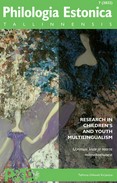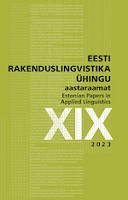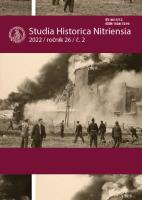Author(s): Vilja Oja / Language(s): Estonian
Issue: 68/2023
The article examines two pairs of lexical homonyms, which are expressed in Estonian by the verb iskima and the noun säsi. In South Estonian dialects and in older written language, iskima is used primarily to mean ’to twist a thread’ and ’to gather together the turns of a thread or rope’. The word is also used to denote other actions, which overlap with the meaning of lööma ’to hit’, e.g. ’to strike fire out’, ’to decorate, make up, change, transform (oneself)’. In Finnic languages, iskiä is widely used in the meaning ’to hit’ and similar, including the meaning ’to weave a string or ribbon’. In Northern Estonia, the Insular dialect and occasionally in the North-Eastern Coastal dialect, iskima ~ i(i)sima means ’to spy, lurk, ambush, track’. Among closely related languages, equivalents of this can be found in some Finnish and Karelian dialects as well as in the Saami languages. Analysis reveals that the word in this meaning is a Russian loan. Thus the word has different etymological origins in different meanings. In Standard Estonian, säsi carries the meanings of ՚soft tissue of internal organs’ and ’plant tissue at the core of a stem or root’, figuratively also ’inside, core’. In South Estonian and Finnish dialects säsi or säsü means ’bone marrow, jelly’. Related languages exhibit the variants säsi / sasu, the root of which is likely of Finnic-Permic or Finnic-Saami origin. In North Estonian Insular dialect and neighboring areas, säsi g sää ~ säe, p sätt occurs in the meaning of ’small smoldering fleck of coal; spark’, figuratively also ’sharp (e.g. tool, intellect)՚. This has an equivalent in Finnish säe(n): säke(n)en as well as in Ingrian and Karelian dialects. It is unclear how the Insular dialect säsi developed and what its relationship is to Müller’s word segko and Finnish säe-: säke- or the Finnic stem säde(m) g sädeme; whether säsi could have emerged through contamination of säde ’spark’ and süsi ’coal’ or is derived from an onomatopoetically motivated stem. The analysis indicates, however, that Standard Estonian säsi and South Estonian säsi / säsü come from the same root, while the Insular dialect word säsi is of a different origin.
More...
![Функционална субституция на средните гласните [e–ɛ] и на широката гласна [e] в устната практика на френския и българския език](/api/image/getissuecoverimage?id=picture_2021_61343.jpg)






